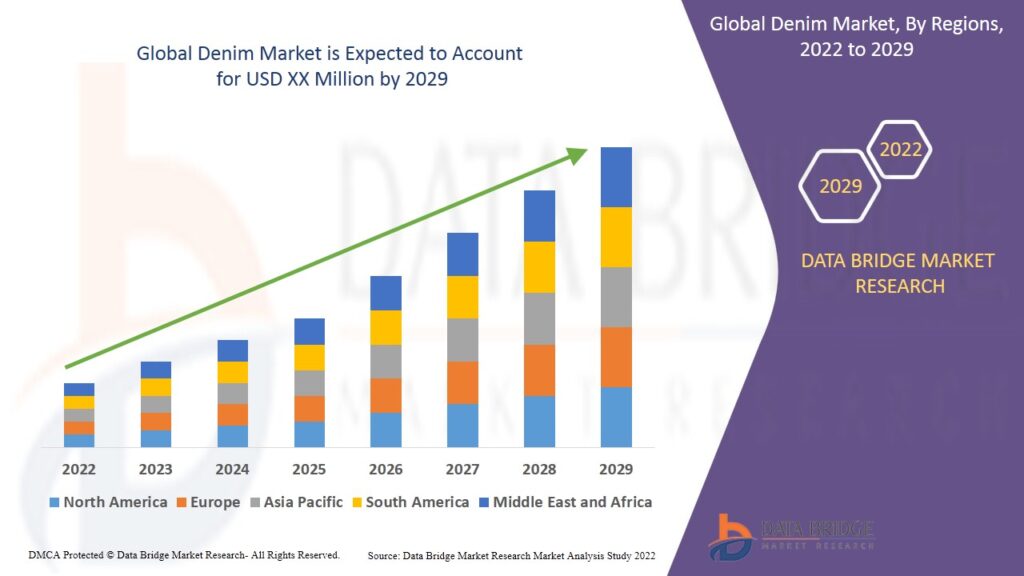Introduction
Denim, once a utilitarian fabric worn primarily by workers, has evolved into a global fashion staple. Today, denim is synonymous with both casual style and cultural identity, transcending age, gender, and geography. The global denim market has seen substantial growth driven by rising fashion consciousness, increasing disposable income, and a surge in demand for sustainable and premium denim products.
As of 2024, the denim market is undergoing a transformation characterized by shifting consumer preferences, innovations in fabric technology, and a strong focus on ethical production. This article explores the key trends, challenges, and opportunities shaping the denim industry globally.
Market Overview
The global denim market was valued at approximately USD 65 billion in 2023 and is projected to reach USD 89 billion by 2030, growing at a CAGR of around 4.5% during the forecast period. While jeans continue to dominate, the market also includes denim jackets, shirts, skirts, dresses, and accessories.
Key factors contributing to this growth include the rising demand for casual wear, the increasing penetration of Western fashion in emerging markets, and continuous innovation in fabric design and sustainability.
Key Market Segments
1. By Product Type
-
Jeans
-
Jackets
-
Shirts
-
Dresses
-
Shorts and Skirts
-
Others (Bags, Hats, Footwear)
2. By End User
-
Men
-
Women
-
Children
3. By Distribution Channel
-
Offline Retail (department stores, specialty stores, supermarkets)
-
Online Retail (e-commerce platforms, brand websites)
4. By Geography
-
North America
-
Europe
-
Asia-Pacific
-
Latin America
-
Middle East and Africa
Market Drivers
1. Rising Casualization of Workwear
With hybrid and remote work becoming more common, there’s a notable shift toward casual clothing in both professional and personal settings. Denim, especially jeans and jackets, is a go-to choice for this dress code transition.
2. Growing Youth Population and Fashion Awareness
A fashion-forward, brand-conscious younger generation is driving demand for trendy and personalized denim styles. Social media platforms amplify denim trends, encouraging global fashion diffusion.
3. Expansion of Fast Fashion and E-Commerce
Fast fashion brands like Zara, H&M, and Shein rapidly replicate denim trends and make them accessible worldwide. Meanwhile, online channels provide broader reach, quick delivery, and diverse choices to consumers.
4. Sustainable and Ethical Denim
Consumers are becoming more environmentally conscious, leading to the rise of sustainable denim made with organic cotton, recycled materials, and water-saving technologies. Brands like Levi’s, Nudie Jeans, and G-Star RAW are leading the way.
Emerging Trends
1. Sustainable Manufacturing Practices
Technological innovations are minimizing the environmental impact of denim production. Techniques such as laser fading, ozone washing, and waterless dyeing are becoming industry standards.
2. Customization and Personalization
Consumers increasingly seek unique denim styles that reflect their personality. Custom fits, embroidery, patches, and DIY aesthetics are gaining traction, especially among Gen Z shoppers.
3. Gender-Neutral Collections
Fashion is moving toward inclusivity, and denim brands are following suit. Gender-neutral denim designs are growing in popularity, providing versatile, comfortable, and stylish options for all.
4. Premium and Luxury Denim
The rise in disposable income in urban centers, coupled with an appetite for high-quality products, has fueled demand for premium denim. Luxury fashion houses like Gucci, Balenciaga, and Dior are incorporating denim into their seasonal collections.
5. Smart and Functional Denim
Innovations in smart textiles are slowly entering the denim space, with products featuring moisture-wicking, stretchable, or temperature-regulating properties gaining attention.
Regional Insights
North America
North America, particularly the United States, remains one of the largest markets for denim. Brands like Levi’s, Wrangler, and American Eagle have a strong foothold, and the trend of denim revival among millennials and Gen Z continues to drive growth.
Europe
European consumers value high-quality craftsmanship and sustainability. Countries like Italy and Germany are key markets, with a preference for premium and ethically produced denim.
Asia-Pacific
The fastest-growing region in the global denim market. In countries like China, India, and Japan, the rising middle class, fashion influence of Western media, and increasing online retail penetration are major growth factors.
Latin America and Middle East
These regions are experiencing growing fashion awareness, particularly among urban youth. Although the markets are smaller in size, they offer untapped potential for denim brands expanding globally.
Key Challenges
1. Environmental Impact
Traditional denim manufacturing is resource-intensive, using large quantities of water, chemicals, and energy. Despite progress, the industry still faces criticism for its environmental footprint.
2. Supply Chain Disruptions
Global denim production relies heavily on international trade. Issues like raw material shortages, geopolitical tensions, and logistic bottlenecks can disrupt supply chains and affect pricing.
3. Counterfeit and Low-Quality Products
The proliferation of counterfeit goods and low-grade denim undermines brand value and erodes consumer trust, particularly in online marketplaces.
4. Changing Consumer Preferences
Fast-changing fashion cycles demand agility from brands. Those unable to adapt quickly to trends risk losing relevance in a competitive market.
Competitive Landscape
The denim market is highly competitive, with both global giants and niche players operating in the space. Key players include:
-
Levi Strauss & Co.
-
Kontoor Brands (Wrangler, Lee)
-
Diesel S.p.A
-
PVH Corp. (Calvin Klein, Tommy Hilfiger)
-
H&M
-
Zara (Inditext SA)
-
Uniqlo (Fast Retailing Co., Ltd.)
-
Gap Inc.
-
Pepe Jeans
-
AG Jeans
These companies are investing in sustainable manufacturing, digital marketing, influencer partnerships, and omnichannel retail strategies to maintain competitiveness.
Future Outlook
The future of the denim market lies in balancing fashion with function, and sustainability with scalability. Brands that embrace ethical practices, innovate with fabrics and fits, and cater to the digitally connected, socially conscious consumer will lead the way.
By 2030, denim is expected to be more than just a fashion item—it will be a symbol of sustainable living, digital customization, and gender-fluid fashion expression.
Conclusion
The global denim market is in a dynamic phase of transformation. From its roots as rugged workwear to its current status as a fashion must-have, denim continues to adapt to cultural shifts, consumer demands, and environmental pressures.
With rising awareness around sustainable fashion, increased global connectivity, and evolving style preferences, the denim industry is poised for a future defined by innovation, inclusivity, and purpose-driven growth.
Get more Details
https://www.databridgemarketresearch.com/reports/global-denim-market






